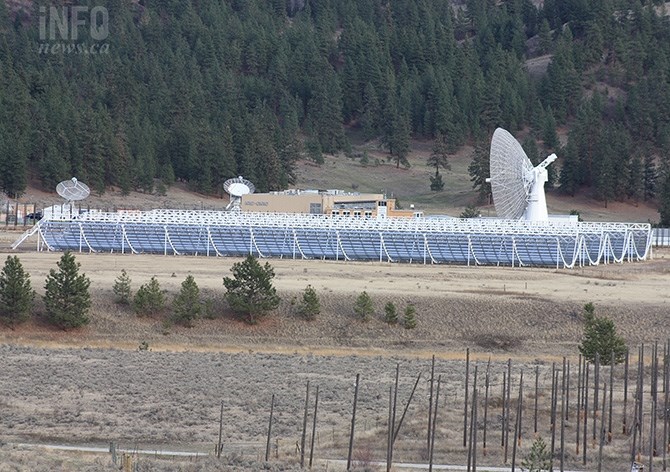
Three outrigger telescope are planned for locations in North America to help Dominion Radio Observatory's CHIME telescope locate Fast Radio Bursts in the universe. One of the sites will be located near Princeton, B.C.
(STEVE ARSTAD / iNFOnews.ca)
August 14, 2020 - 6:30 AM
Astronomers at the South Okanagan’s Dominion Radio Observatory are planning an expansion to the CHIME telescope following its initial success at detecting Fast Radio Bursts.
Dominion Radio Observatory astronomer Jane Kaczmarek says the observatory’s CHIME telescope has been “unbelievably revolutionary” at detecting Fast Radio Bursts since it was activated in 2017.
“The FRBs were first discovered in 2006. Up to the time CHIME was activated we’d found around 20 but since then, CHIME has discovered thousands,” Kaczmarek says.
“The problem with CHIME is it’s ‘near-sighted.’ It can see a good chunk of the sky at once, but everything is fuzzy, and we can’t locate where these bursts are coming from,” she says.
The observatory is now embarking on the next step in the evolution of the CHIME telescope that will help astronomers locate the elusive bursts through the development of "outrigger telescopes."
DRAO has received funding for one of three planned outriggers, the first of which will be located just south of Princeton in the Allenby area.
The other two outriggers will be built at the Algonquin Radio Observatory in Ontario, and the Green Bank Observatory in West Virginia, pending funding from the U.S.-based National Science Foundation.
The outrigger telescope at Allenby will be 10 per cent of the size of the CHIME telescope at the Dominion Observatory, consisting of a single cylinder 30 metres long compared to CHIME’s four-cylinder, 100-metre length.
Kaczmarek says the outrigger telescopes will give astronomers the ability to triangulate where the pulses are coming from.
The science is known as Very Long Baseline Interferometry.
The technology was actually developed in Canada in 1963, originally used between Dominion Radio Observatory’s telescope and one in Algonquin Park, Ontario.
“We still don’t know what Fast Radio Bursts really are. It’s a big question that other telescopes around the world are working on as well. We’re hoping with these new outrigger telescopes we’ll be able to identify the galaxy as well as what part of the galaxy these things are coming from,” she says.
The bursts can be used as snapshots of cosmic time that can be used to build a picture of the evolution of the universe once their origin is known.
Kaczmarek says the observatory hopes to have the Allenby telescope operating by winter. With just the one outrigger, she says CHIME’s performance will exceed that of other telescopes it currently competes with internationally.
The telescope will be used to prove Very Long Baseline Interferometry will work with the short baseline provided by the Allenby location (85 km), in addition to picking up new science that can be applied to the other sites.
To contact a reporter for this story, email Steve Arstad or call 250-488-3065 or email the editor. You can also submit photos, videos or news tips to tips@infonews.ca and be entered to win a monthly prize draw.
We welcome your comments and opinions on our stories but play nice. We won't censor or delete comments unless they contain off-topic statements or links, unnecessary vulgarity, false facts, spam or obviously fake profiles. If you have any concerns about what you see in comments, email the editor in the link above.
News from © iNFOnews, 2020